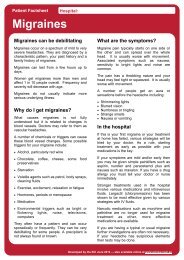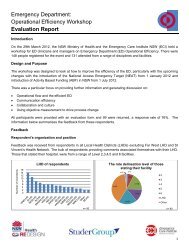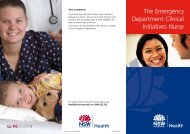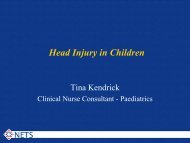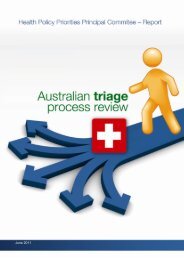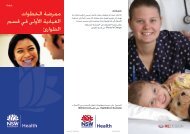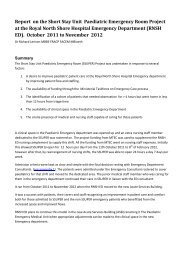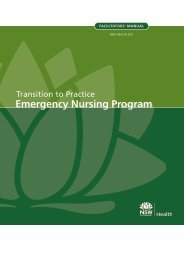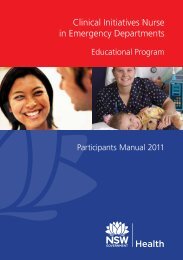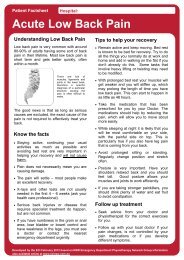Emergency Department Models of Care 2012 - NSW Health
Emergency Department Models of Care 2012 - NSW Health
Emergency Department Models of Care 2012 - NSW Health
- No tags were found...
Create successful ePaper yourself
Turn your PDF publications into a flip-book with our unique Google optimized e-Paper software.
■■The size <strong>of</strong> the MAU bed-base or co-location to another ward will determine the FullTime Equivalent (FTE) for dedicated Allied <strong>Health</strong> staffing. The MAU patient group (forexample, paediatrics, geriatrics, general medical patients) will inform the Allied <strong>Health</strong>staff selected to work in the MAU.7-day-per-week dedicated Allied <strong>Health</strong> Staff (especially Physiotherapy, OccupationalTherapy and Social Work staff) are recommended. FTE provisions should be made asnecessary for staff from pharmacy, dietetics, Speech Pathology, Allied <strong>Health</strong> Assistants,and play therapy.Support Staff:■■Clerical support and Clerical Support Officers (CSO) as per normal inpatient wardarrangementsDedicated porter/wardsperson/patient transport staff is recommended for units withgreater than 15 beds. These services have been shown to decrease delays in patienttransport and movements.Physical space■■Located close to or co-located to the ED but recognised as a separate unit.Within close proximity to diagnostic facilities and services (pathology, radiology andpharmacy). It has been shown that increased distance to diagnostic services reduces thelikelihood <strong>of</strong> immediate transfer <strong>of</strong> patients to MAU.Business rulesIt is recommended that the MAU business rules contain:■■Admission criteria (inclusive <strong>of</strong> any exclusion criteria)An example <strong>of</strong> admission criteria: The MAU is available for all adult patients who areconsidered to be a medical admission, require a period <strong>of</strong> assessment and diagnosticreview, are non-critical and stable and do not require resuscitation and stabilisation.■ An example <strong>of</strong> Exclusion Criteria is given here in Table 1.Table 1: Exclusion CriteriaExcluded PatientsCritical <strong>Care</strong>High Dependency AirwayUnstableNeurologicalSurgicalRenalSpeciality careComplex/Undifferentiatedpatients who are unstableMental <strong>Health</strong>Challenging BehavioursOtherAny patient who is to be admitted to ICU, CCU, HDU or othercritical care unitsThreatened airway or any patient who requires BiPAP or CPAPResp rate 36/minO2Sat




